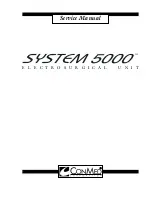
3-1
TM
System 5000™ functions and essential circuit information are provided in this section. This section begins
with a description of the key parameters for each mode. This is followed by an overview of how the system
functions and some key operational information for the modules within the system.
3.1
Mode Descriptions
The key functional parameters for each mode are presented here. Nominal mode specifications are provided
in section 1.2.11.
3.1.1 Cut Major Modes
Major
mode
Minor
Mode
RF frequency
Modulation: Number of
Pulses, Time on/off
Modulation: Frequency &
period
CUT
PURE
391 KHz
None
None
BLEND 1
391 KHz
16 pulses
40μs/10μs
20 KHz
50μs
BLEND 2
391 KHz
11 pulses
28μs/23μs
20 KHz
50μs
BLEND 3
391 KHz
10 pulses
26μs/24μs
20 KHz
50μs
Theory of Operation
Section 3.0
Activation of Pulse Cut will make the selected cut
mode, Pure Cut, Blend 1, Blend 2, or Blend 3
active for 70 milliseconds every 600 milliseconds.
NOTE: The low duty cycle of Pulsed Cut mode
makes the average power very low – about 12%–
when compared with the power displayed on the
front panel. The period is also long causing most
ESU analyzers to provide erratic or erroneous
readings. Correct power can be verified by mea-
suring the peak to peak current and comparing the
value with the current measured in the non-pulsed
mode.
3.1.2 COAG Major Modes
Major
mode
Minor Mode
RF frequency
Modulation: Number
of Pulses, Time on/off
Modulation:
Frequency & period
COAG
PINPOINT
391 KHz
4 pulses
10μs/40μs
20 KHz
50μs
STANDARD
562 KHz
Single pulse
39 KHz
SPRAY
562 KHz
Single pulse
19 KHz
Activation of Pulse Coag will make the selected
coag mode, either Standard or Spray, active for
2.5 milliseconds every 5 milliseconds. Displayed
power setting will represent the average power
being delivered which is approximately half the
power delivered during the pulses.
Standard and Spray Coag modes are fundamental-
ly different from the Cut modes in that the reso-
nant circuit of the RF Amplifier and Transformer
combination is excited by the energy of a single
pulse, causing the resonant circuit to ring until
the energy is dissipated. Circuitry in the amplifier






































